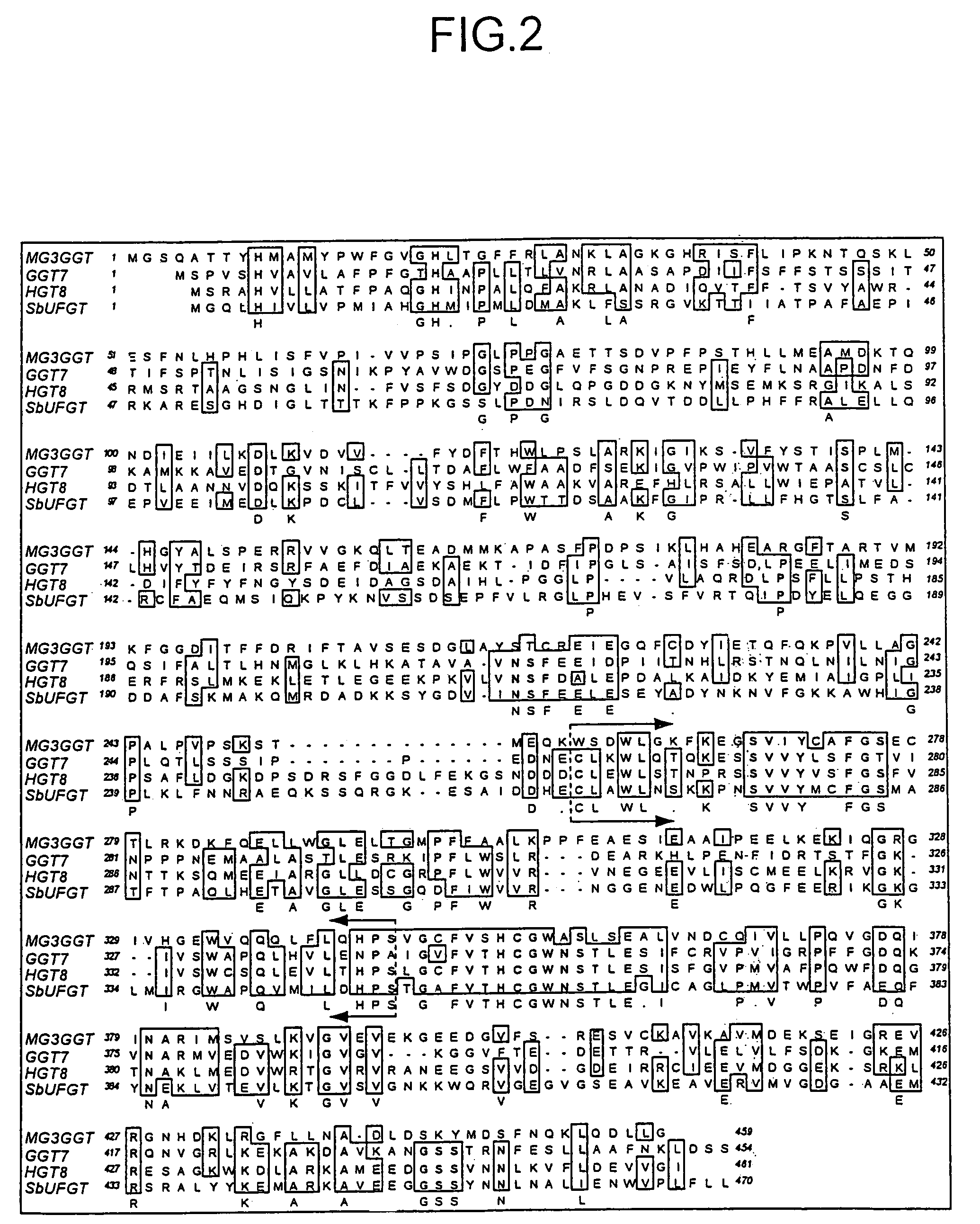Glycosyltransferase gene
a technology of glycosyltransferase and enzyme, which is applied in the field of enzyme gene, can solve the problems of inability to make flowers with all colors in the target species, inability to measure the activity of the enzyme which catalyzes the reaction, and inability to make thc extremely unstable at ph
- Summary
- Abstract
- Description
- Claims
- Application Information
AI Technical Summary
Benefits of technology
Problems solved by technology
Method used
Image
Examples
example 1
Construction of cDNA Library of Carnation Flower Petal
[0063]RNA was isolated from 5 g of fresh flower petals of yellow carnation by a method using guanidine thiocyanate / cesium chloride shown in detail in “Method in Molecular Biology” Vol. 2 (Humana Press Inc., 1984), and poly-A+RNA was purified using Oligotex dT30 (Nippon Roche KK). A cDNA library was constructed from this poly-A+RNA using cDNA synthesis Kit (Stratagene) and λZAPIIUni-XR vector Kit (Stratagene). The resulting library contained 1.6×105 plaque forming units.
example 2
Isolation of Full Length Gene of Glycosyltransferase on Position 2′ of Chalcone
[0064]DNA fragments composed of nucleotide sequences corresponding to conservative regions (regions indicated by paired arrows in FIG. 2) obtained by comparing the amino acid sequences of glycosyltransferases (GT) shown in FIG. 2 were amplified, and using them as probes, the cDNA library of the carnation described in Example 1 was screened. The compared amino acid sequences are 4 kinds of the amino acid sequences of UDP glucose: anthocyanidin 3-glycoside glycosyltransferase (3GGT) derived from the morning glory (amino acid sequence described in SEQ ID NO:13), UDP-glucose: anthocyanin 3-glycosyltransferase (3GT) derived from the gentian (Plant Cell Physiol., 37:711, 1996), UDP-glucose: anthocyanin 5-glycosyltransferase (5GT) derived from the verbena (J. Biol. Chem., 274:7405, 1999) and Scutellaria baicalensis glycosyltransferase (GT) (Planta 210:1006-1013, 2000). For each GT, an oligonucleotide which can a...
example 3
Amino Acid Sequence Analysis of Glycosyltransferase on Position 2′ of Chalcone, T170
[0068]pT170 contained the gene T170 of 1709 bp encoding a protein with molecular weight of 54.2 kDa composed of 490 amino acid residues. The amino acid sequence encoded by the T170 gene was compared with those of glycosyltransferases already reported, and consequently, exhibited 25% homology with GT derived from livingstone daisy (Plant J. 19, 509 (1999)) and 21% homology with 5GT derived from perilla and verbena. Software used was Clustal W included in MacVector ver. 6.0 (Oxford Molecule), and the analysis was performed under the condition of matrix blosum: 30, ketuple: 1, gap penalty: 3, topdiagonals: 5, and window size: 5. In BLAST search (the search was performed under the default condition. That is, under the condition of composition-based statistics: on, choose filter: low, complexity matrix: blosum 62, gap costs: existence 11 and extention 1), the homology with those of various GT was observed...
PUM
| Property | Measurement | Unit |
|---|---|---|
| pH | aaaaa | aaaaa |
| pore size | aaaaa | aaaaa |
| pore size | aaaaa | aaaaa |
Abstract
Description
Claims
Application Information
 Login to View More
Login to View More - R&D
- Intellectual Property
- Life Sciences
- Materials
- Tech Scout
- Unparalleled Data Quality
- Higher Quality Content
- 60% Fewer Hallucinations
Browse by: Latest US Patents, China's latest patents, Technical Efficacy Thesaurus, Application Domain, Technology Topic, Popular Technical Reports.
© 2025 PatSnap. All rights reserved.Legal|Privacy policy|Modern Slavery Act Transparency Statement|Sitemap|About US| Contact US: help@patsnap.com


